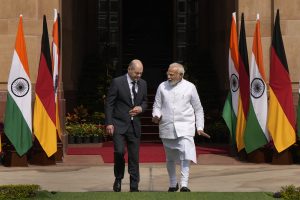The visit by the German chancellor to India on February 25-26 opened a new page in India-Germany relations. Shedding the image of a traditionalist, Olaf Scholz did not shy away from stepping into a tea shop on a street corner in New Delhi. The public posturing of the 64-year-old Scholz was probably influenced by the need to reach out to a larger Indian audience in a time of geopolitical uncertainty and strategic opaqueness. However, Scholz’s visit, his first to India since his election in December 2021, will not be known just for the “chai sipping in Chanakyapuri,” but for the promising specter of a bond he unveiled between the people of two democracies during his trip.
Defense cooperation with India has always remained an attractive sector for Germany, which lags behind countries like France with which India has several agreements and purchase or manufacturing deals. The Ukraine crisis of 2022 initiated a dramatic shift, a Zeitenwende (turning point) in German foreign policy and defense orientation when Scholz announced a massive increase in the defense budget. India could be one of the beneficiaries of this changed orientation. The media, quoting unnamed German and Indian officials, highlighted a possible German offer worth $5.2 billion to build six conventional submarines in India. India’s navy urgently needs to replace many of its existing submarines and to have 24 operational submarines by 2030. In this regard, the reported German offer could be important.
However, what continues to play an impediment is India’s emphasis on “Make in India.” New Delhi in the past has insisted that Germany has to fully transfer technologies for the submarines to India, sharing the full spectrum of submarine manufacturing from the design stage to development. Germany has found it hard to comply with that. It is yet to be seen whether India’s strategic need for submarines and Germany’s need to deepen the defense sector collaboration has led any of the countries to dilute their demands.
China has been an important factor with European nations pursuing their respective Indo-Pacific strategy. India and Germany share common interests with regard to a free and open Indo-Pacific and maintaining a multilateral order. India’s ongoing border standoff with China and its host of other differences with Beijing creates ample common ground for strategic cooperation between such countries and New Delhi. The German Indo-Pacific guidelines of 2020 identifies India as one of Germany’s most important partners in the region. China’s growing presence in the Indian Ocean and India’s concerns with that, however, has not really translated into New Delhi reaching out to new partners as an act in counter-balancing.
India’s continued import of Russian fuel and refusal to renege on its neutral position in Russia’s Ukraine war has been a matter of irritation to the West. Even with the statements made by different European leaders that they appreciate and understand the Indian position, pressure on India to change track continues to mount. For instance, media reports indicated that in the recent vote in the U.N., India was specifically asked by the U.S., U.K., Germany, and France to vote alongside them. New Delhi, however, chose to abstain. In spite of these differences, the formal placement of defense cooperation on the agenda could be a significant step forward made during Scholz’s visit.
A large business delegation traveled with Scholz focusing on the possible areas of cooperation and business opportunities that interest them. Some of them met with Indian Prime Minister Narendra Modi to discuss new opportunities for German firms to expand their footprint in India. Clean energy, trade and new technologies are three popularly identified sectors. Healthcare and infrastructure are other attractive areas for Germany, which is India’s largest trade partner in Europe and one of its top investors. In January 2023, German engineering giant Siemens received the order to deliver 1,200 electric locomotives and provide 35 years of full-service maintenance from the Indian Railways. These developments indicate that both countries are being able to gradually break down walls of tariff related and other differences and would be able to progress towards an India-European Union trade deal in future.
What, however, managed to hog the limelight, during the visit was the chancellor’s “chai pe charcha” with a difference, beyond his official consultations. On the second day of the visit, he flew to Bangalore to meet IT professionals at SAP Labs India. It is there that he outlined his wish to “establish a new system that allows people to apply for a visa to Germany who still have not signed a specific job contract, but who come with a lot of talent and skills, and then find a job in Germany.” And yet, no specifics on how many workers Germany wishes to attract from India were provided. The chancellor’s plan is ostensibly fueled by Germany’s tight labor market and a shortage of workers with software engineering skills. Many German companies are looking at thousands of layoffs in Silicon Valley as a potential opportunity to tap the top talent. India therefore figures prominently in their imagination.
The chancellor’s visit has created an enabling environment for wider consultations between the two countries at various levels. This calls for more wide-ranging exchange between the academia, media, business, women, youth and civil society groups, and more linkages at the subnational level. Setting up consultative committees to work on common areas of interest- trade, technology, green energy, education and health could be a useful mechanism in strengthening the relationship. Beyond the optics, the strength of the relationship lies in building greater people to people connect.
In times of strategic opaqueness and geopolitical uncertainty and especially with India leading the G-20 forum, the visit came as a fresh breath of air in terms of public diplomacy. Scholz’s outreach has the potential enlarge the canvas of cooperation between the people of both the countries thereby building enduring partnership in times to come. It is time for New Delhi to build on such opportunities and leverage its position on the global stage.

































